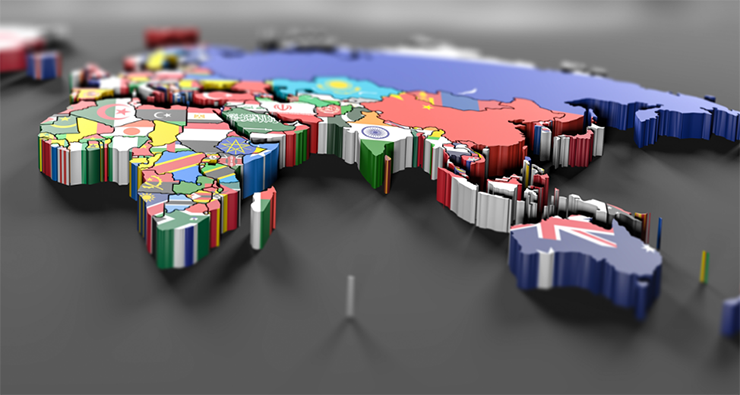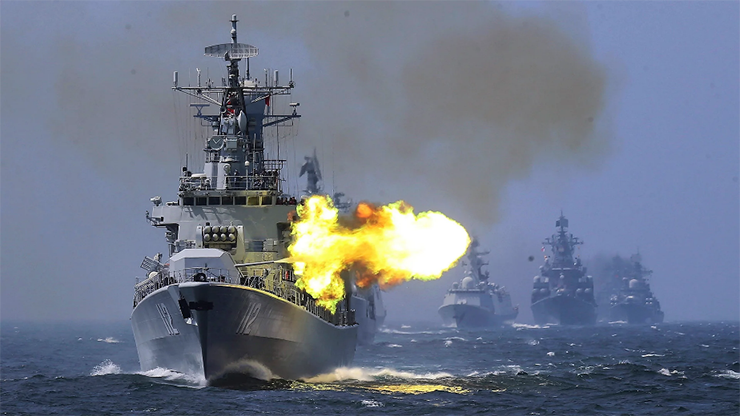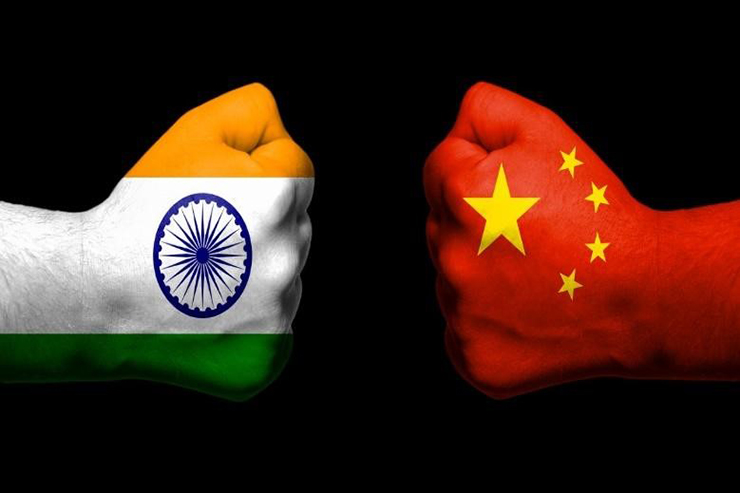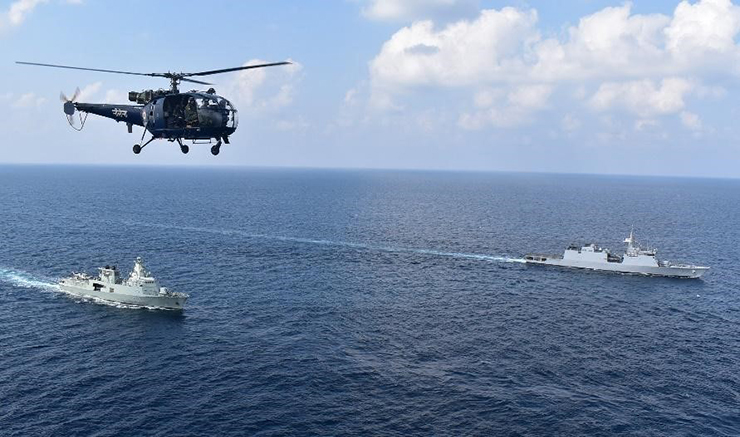
The Indo Pacific: As the US realigned its focus back to the emerging Chinese threats in Asia in 2018, it rechristened the region as Indo-Pacific. The name change was purposeful to indicate a seamless connection between the Indian and Pacific Oceans in the context of security in the region. It also better represented resources that the US considered essential for its continued domination of this complex region. The terminology was immediately welcomed by US partners and a retort from China and Russia.
China saw the move singularly targeted at it. In a commentary carried by Global Times in December 2020, it was suggested that the change of name is a US strategy to draw in India to counter China’s rise as the ‘center of power’ in Asia. Russia refused new assertions, choosing to abide by its definition of Asia Pacific. It only amplifies how complex regional geopolitics has become. The Chinese assertiveness and plain denial of facts have only made matters worse.

The Indian Navy, which traditionally focused on the security of the Indian Ocean and the Arabian Sea as its prime domain, was also faced with new challenges in the East and Western Pacific. The emerging maritime threats were raising newer concerns, and movement in its eastern corridor was getting restricted by the day, with China’s fanciful claims at alarming regularity. Indian foray with Vietnam oil exploration was objected to by China on dubious claims over EEZ. An Indian Navy ship was intercepted in high sea by a Chinese patrol craft on its way to Vietnam for a port call in 2011. India quickly figured out China’s attempts to squeeze out operational space in its Eastern neighbourhood.
The three-pronged approach that China focuses on during its naval deployment is – first, dissuasion of the US and its allies from coming closer to its stated territorial claims; secondly, maintaining enough military pressure closer to the Taiwan strait for presenting a realistic backing to its routine threats; and thirdly, to ensure strong power projection beyond its maritime boundary and appear as a viable Blue Water Navy
Chinese Aggression
Continued adventures of China in the South and East China Sea set a pattern and gave a clear message that it wanted to be an undisputed power in what it considers its sphere of influence. China pressured its immediate neighbours Malaysia, Indonesia, Vietnam, and the Philippines to forego their historical claims. China backed its messaging with menacing naval power, especially in the South China Sea. In the last decade, China picked more territorial and maritime disputes than in its entire history of existence. It disputes Japanese claims over the Senkaku Islands. It has territorial disputes with Bhutan, Nepal, and India. All this is apart from its claims on the entire of Taiwan. Today, China has territorial and maritime disputes with at least 10 countries.
The Chinese Navy constitutes almost 350 surface ships and submarines, and it is the second largest navy after the US Navy and has migrated from Green Water to a Blue Water Navy in recent years. The three-pronged approach that China focuses upon with its naval deployment is – firstly, dissuasion of the US and its allies from coming closer to its stated territorial claims; secondly, maintaining enough military pressure closer to the Taiwan strait for presenting a realistic backing to its routine threats; and thirdly, to ensure strong power projection beyond its maritime boundary and appear as a viable Blue Water Navy.

What concerns India in particular is the Chinese conduct in the waters around it. China’s push for extended EEZ for itself in violation of ICJ’s verdict creates a problem for Indian entities to engage with ASEAN partners in offshore explorations. It also creates difficulty in conducting naval exercises for engaging new partners towards the East, as almost all of the South China Sea is aggressively patrolled by Chinese boats. China’s continued push southward has created a security concern for India’s Island territories of Andamans. The recent anchoring of the Chinese naval ship Shi Yan 6 at Colombo termed a ‘research ship’ by China has created hackles for Indian security establishments. China also routinely sends its surveillance ships to monitor Indian space and rocket launches. China effectively wishes to keep its presence in the waters around it well dominated to get an adequate early warning in any eventuality.
China has territorial and maritime disputes with at least 10 countries. It has pressured its neighbours Malaysia, Indonesia, Vietnam, and the Philippines to forego their historical claims. China’s push for extended EEZ in violation of ICJ’s verdict creates a problem for Indian entities to engage with ASEAN partners in offshore explorations. China’s southward push has created a security concern for India’s Island territories of Andamans
Redrawing Strategies
The Indian Navy has been operating in the region for a long time and fully understands Chinese tantrums. It would have identified adequate vulnerabilities for the Chinese Navy operating closer to Indian maritime interests while plugging its operational gaps. The Indian Navy in recent years seems to be redrawing its strategies towards better control of waters around the East extending to the Pacific and maintaining its dominant presence in the West. The Indian Navy would also want to focus on unmanned capabilities both above and underwater. In modern decision-centric warfare, enhanced 3600 surveillance capabilities are essential. The Indian Navy looks to strategically invest in reconnaissance aircraft like six additional P-8I Poseidon, Airbus C-295 transport aircraft are set to be modified as Medium Range Maritime Reconnaissance aircraft by the DRDO, high-speed Saryu class patrol crafts, Heron UAVs and anti-submarine ships to effectively counter Chinese Navy’s aggressive forays in the Indian Ocean.

Projects 75 & 75(I) have led India towards greater indigenisation of modern submarines, which will start impacting its operational efficiency in the near term. The second aircraft carrier INS Vikrant was commissioned in September 2022 and was expected to complete flight trials by the end of 2023. This would give a strong fillip to the Indian Navy’s power projection beyond its immediate maritime interests. India is also planning to add its third aircraft carrier tentatively named INS Vishal, which if goes as per plans should materialise by 2030. Recent announcements of the acquisition of 26 Rafale-Marine fighter jets, three Scorpion class diesel-electric submarines, and five fleet support ships will add to the muscles and reach the high sea. As of now multiple destroyers; frigates; corvettes; and conventional-powered and nuclear-powered submarines totaling around 45 different ships are under indigenous construction. India has its plans ready to build a true Blue Water Navy by 2050 with more than 200 vessels and 500 aircraft.
The Indian Navy seems to be redrawing its strategies towards better control over waters around the East, extending to the Pacific and maintaining its dominant presence in the West. The Indian Navy would also want to focus on unmanned capabilities both above and underwater. India plans to build a true Blue Water Navy by 2050 with more than 200 vessels and 500 aircraft
Strategic Independence
The Indian Navy will likely have to work on multiple footings simultaneously. It needs to enhance its visibility and reach towards the East while further augmenting capabilities in the West. Acquisitions of new capabilities will be crucial, while the Navy has achieved substantial indigenisation it must also continue to pitch for high-end foreign acquisitions. These assets would be tools for strategic independence and power projection. The Indian Navy also needs to move forward in defining its role as the security environment has undergone a sea change in the last decade. Also, the Navy is expected to bear the bulk of responsibility for ensuring India’s burgeoning sea-based trade and commerce flourish in a secure space.
India has been working actively with friends and partners in identifying and stabilising alternate supply chains. This can only be possible if maritime routes remain safe and secure. The Indian Navy must explore opportunities to further integrate with other like-minded regional and global powers operating in the region. Coordination for training and operation would considerably ease the burden of assets and improve interoperability, a key factor for operational success. It’s time that the Indian Navy must demonstratively be seen to be a viable force with resolve and capacity. It will enable India to become a “preferred & equal partner” in forums like QUAD and strongly propagate India’s global vision!
– The writer, experienced in security and geopolitics, contributes to national publications. His articles can be read on the popular website newsanalytics.in, focusing on geostrategic affairs















